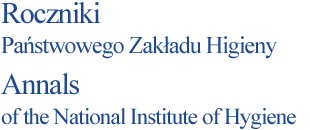RESEARCH PAPER
Iron status in women of reproductive age in Morocco
1
Ibn Tofail University-CNESTEN, Joint Research Unit in Nutrition and Food, RDC-Nutrition AFRA/IAEA, Rabat-Kénitra, Morocco
2
Ministry of Health, Rabat, Morocco
3
Higher Institute of Nursing and Health Technical Professions, Laayoune, Morocco
Submission date: 2024-12-01
Final revision date: 2025-03-15
Acceptance date: 2025-03-25
Online publication date: 2025-04-17
Publication date: 2025-06-26
Corresponding author
Rocz Panstw Zakl Hig 2025;76(1):47-54
KEYWORDS
TOPICS
ABSTRACT
Background: Women of reproductive age (WRA) are one of the vulnerable population mostly impacted by anemia and iron deficiency (ID) worldwide. Objective: This study aimed to assess the prevalence of anemia, ID, and iron deficiency anemia (IDA) among WRA in Morocco. Material and Methods: This study included a representative sample of 2,012 non-pregnant women aged 15-49 years covering the entire territory of Morocco. Data collection encompassed socio-demographic information, anthropometric measurements, along with blood samples. Hemoglobin (Hb) concentration, serum ferritin (SF), and C-reactive protein (CRP) levels have been analyzed. Results: The median of SF for the entire population was 27 μg/mL (Interquartile Range (IQR): 12-50 μg/mL), and the mean of Hb was 12.2 ± 1.5 g/dL. Significant differences were observed between urban and rural areas: urban SF median was 24 μg/mL (IQR: 11-45 μg/mL) versus rural 31 μg/mL (IQR: 15-55 μg/mL, p < 0.001), and urban Hb mean was 12.2 ± 1.5 g/dL compared to rural 12.4 ± 1.5 g/dL (p = 0.02). Furthermore, the prevalence of anemia, ID and IDA are consistently high; 34.3%, 29.8%, and 16.4%, respectively, with a significant difference in favor of urban areas. Conclusions: Our findings from this national survey reveal that despite over a decade of implementing flour fortification strategy using electrolytic iron to address iron deficiency in Morocco, anemia, ID, and IDA remain widespread among WRA. Exploring alternative strategies or adopting a different form of iron for fortification could be beneficial in reducing or even eradicating iron deficiency among Moroccan women.
Share
RELATED ARTICLE
We process personal data collected when visiting the website. The function of obtaining information about users and their behavior is carried out by voluntarily entered information in forms and saving cookies in end devices. Data, including cookies, are used to provide services, improve the user experience and to analyze the traffic in accordance with the Privacy policy. Data are also collected and processed by Google Analytics tool (more).
You can change cookies settings in your browser. Restricted use of cookies in the browser configuration may affect some functionalities of the website.
You can change cookies settings in your browser. Restricted use of cookies in the browser configuration may affect some functionalities of the website.



